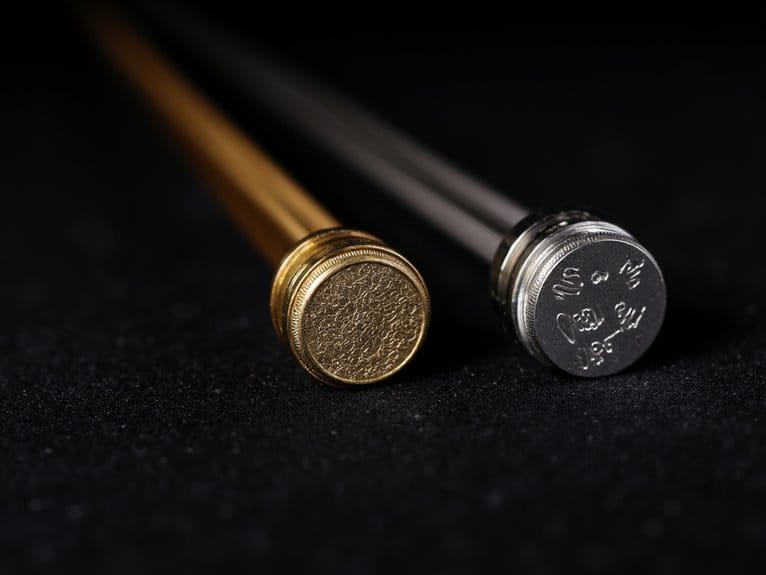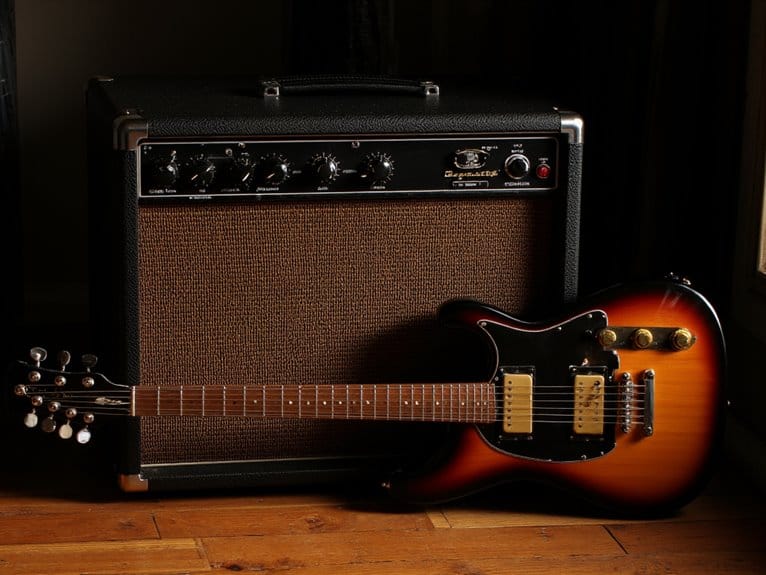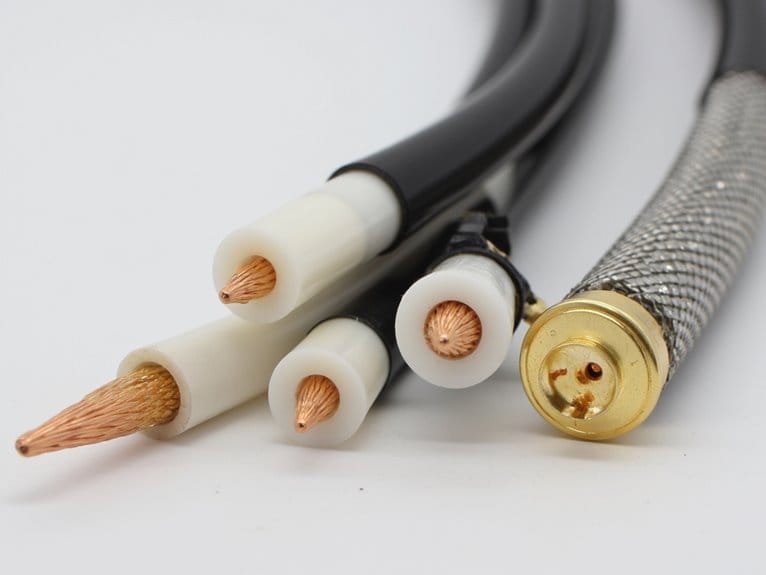Bass String Materials: Nickel Vs Stainless Steel
When you’re choosing between nickel and stainless steel bass strings, you’re selecting between warm versatility and aggressive brightness. Nickel strings offer smoother feel with balanced mids that work beautifully for jazz, blues, and fingerstyle playing, though they’ll corrode faster from your sweat. Stainless steel delivers crisp, punchy attack perfect for slapping techniques and cutting through rock or metal mixes, plus they’ll last considerably longer despite feeling slightly coarser under your fingers—and there’s more nuance to take into account.
We are supported by our audience. When you purchase through links on our site, we may earn an affiliate commission, at no extra cost for you. Learn more.
Notable Insights
- Stainless steel strings produce bright, aggressive tones ideal for rock and metal, while nickel offers warmer, balanced sound for jazz and blues.
- Stainless steel provides superior corrosion resistance and longevity, lasting decades compared to nickel strings which deteriorate faster from sweat and humidity.
- Nickel strings feel smoother and reduce finger fatigue, while stainless steel has a coarser surface that enhances grip for aggressive playing techniques.
- Stainless steel strings accelerate fret wear due to their hardness, whereas nickel strings are gentler on frets but require more frequent replacement.
- Stainless steel excels for slapping and cutting through heavy instrumentation, while nickel complements fingerstyle playing and controlled dynamics.
Sound Characteristics and Tonal Differences
When you’re choosing between stainless steel and nickel bass strings, the tonal differences you’ll hear are quite dramatic, affecting everything from the initial attack to the harmonic complexity that sustains throughout each note.
Stainless steel delivers a crisp, bright tone profile with aggressive punch, making it perfect for slapping and modern techniques, though some players find the high frequencies harsh rather than pleasant.
Stainless steel strings produce bright, aggressive tones ideal for slapping techniques, though some find the highs overly harsh.
Nickel strings offer superior tonal warmth with balanced mids and smoother top-end response, creating versatility across genres from country to R&B. The smooth playability of nickel strings makes them comfortable and enjoyable, allowing for effortless finger sliding and extended playing sessions.
While steel emphasizes zingy highs and punchy lows, nickel provides fuller midrange presence and harmonic richness, resulting in better sustain and more expressive character for subtle playing styles. Both string types offer high-quality performance and comparable durability, making the choice ultimately dependent on your specific tonal preferences and playing requirements.
D’Addario XL Chromes demonstrate how stainless steel materials can be crafted with a hex-core design to achieve superior intonation and tonal consistency that performs reliably over extended playing sessions.
Nickel-plated steel strings combine the brightness of steel with the warmth of nickel, offering enhanced flexibility that makes them particularly suitable for fretless bass and fingerstyle playing techniques.
Since different string materials interact uniquely with your instrument, a bass preamp can help you shape and optimize your tone regardless of whether you choose stainless steel or nickel strings.
Durability and String Longevity
While tonal characteristics might draw you to one string material or another, I’ve learned that durability considerations often prove more decisive in the long run, especially if you’re playing regularly or performing in challenging environments.
Stainless steel’s superior corrosion resistance means you’ll get extended string lifespan when dealing with sweat, humidity, or outdoor gigs, while nickel strings deteriorate faster under these conditions.
However, stainless steel‘s harder material properties create a trade-off—they’ll accelerate fret wear compared to nickel’s gentler touch on your fingerboard.
If you’re an aggressive player using slapping techniques, stainless steel’s mechanical resilience typically outlasts nickel, though you might sacrifice some tonal stability over time as that bright zing fades. The greater tensile strength of stainless steel also means these strings can handle higher tension tunings without snapping under pressure.
Some manufacturers have developed cryogenic treatment processes that can extend the lifespan of conventional strings up to twice their normal duration, offering an alternative approach to durability enhancement.
Since string durability affects your overall playing experience and maintenance costs, consider how proper fretwork on your instrument will interact with your chosen string material over extended playing sessions.
Feel and Playability Experience
Beyond the sonic differences that initially catch your attention, the tactile experience of playing different string materials creates distinct physical sensations that’ll considerably influence your comfort, technique execution, and overall playing enjoyment.
The physical feel of strings under your fingertips shapes your playing experience as much as their sonic characteristics.
This playability comparison reveals fundamental differences in how these materials interact with your fingertips. Nickel strings offer a smoother, slicker surface that facilitates fluid slides and reduces finger fatigue during marathon sessions, while stainless steel provides coarser tactile feedback that enhances grip for aggressive techniques like slapping but requires a breaking-in period.
- Surface texture: Nickel feels silk-smooth under fingers, while stainless steel’s rougher surface provides more grip but can increase finger noise.
- Attack response: SS delivers immediate, crisp articulation; nickel offers softer, more controlled dynamics.
- Physical comfort: Nickel reduces fatigue and effort required for muting techniques compared to stiffer stainless steel.
Corrosion Resistance and Maintenance Requirements
Although string construction might seem purely technical, the materials you choose will dramatically determine how often you’ll find yourself reaching for fresh strings, cleaning supplies, or dealing with the frustration of corroded windings that’ve lost their punch.
Stainless steel’s chromium content creates a protective barrier that resists rust for decades, while nickel alloy strings corrode faster when exposed to sweat and humidity. These corrosion effects directly impact your wallet and tone quality over time.
My maintenance tips focus on wiping strings after each session, though stainless steel tolerates neglect better than nickel. You’ll replace nickel strings more frequently as oxidation dampens brightness and causes tuning instability, whereas stainless steel maintains consistent performance longer, offsetting its higher upfront cost.
Genre Suitability and Musical Applications
The sonic characteristics that determine your string replacement schedule also shape which musical territories each material conquers most effectively.
Frankly, I’ve watched too many bassists struggle with tone simply because they picked materials that fought against their genre rather than enhancing it.
Choose string materials that complement your musical style instead of sabotaging your sound before you even plug in.
Stainless steel’s aggressive brightness dominates rock, metal, and funk territories, delivering the punchy attack needed for slapping techniques and cutting through dense mixes.
Meanwhile, nickel’s warmer midrange response serves jazz, blues, country, and R&B exceptionally well, providing the smooth dynamics these musical genres demand from fingerstyle playing styles.
When selecting your first instrument, consider that many affordable bass guitars feature pickup configurations specifically designed to complement different string materials across these various genres.
For acoustic bass applications, phosphor bronze strings provide exceptional warmth and clarity that works beautifully across multiple genres.
The choice between Alnico magnets and ceramic pickups can further enhance how your chosen string material translates through your amplifier and into the mix.
- Rock/Metal: Stainless steel’s sharp attack cuts through high-gain amplification and heavy instrumentation
- Jazz/Blues: Nickel’s round tones enhance subtlety and warmth in acoustic or clean settings
- Funk: Both materials work, but steel excels for aggressive slap techniques
Frequently Asked Questions
Can I Mix Nickel and Stainless Steel Strings on the Same Bass?
You can mix nickel and stainless steel strings on your bass without string compatibility issues. You’ll experience tonal differences across strings, with nickel providing warmth and steel offering brightness, creating unique hybrid sounds.
Do Nickel or Stainless Steel Strings Work Better With Active Pickups?
You’ll find both materials offer excellent pickup compatibility with actives, but stainless steel provides brighter tone response and higher output, while nickel delivers warmer, more balanced sound through your preamp.
Which String Material Is Easier for Beginners to Learn On?
You’ll find nickel strings easier to learn on due to superior finger comfort and smoother feel. Their warmer tone preference suits beginners better than stainless steel’s brightness, reducing finger fatigue while developing technique.
On a final note
You’ll find that choosing between nickel and stainless steel bass strings ultimately depends on your playing style, musical preferences, and maintenance habits. If you’re prioritizing warmth and comfort, nickel strings offer that classic, mellow tone with easier playability. However, if you need brightness, longevity, and corrosion resistance, stainless steel delivers superior durability and cutting power for aggressive genres, making either choice valid for different musical applications.







